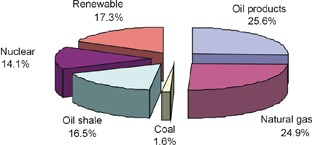The governments of the three Baltic States strongly emphasise the need for additional links while much preparatory work has already been done in the context of the construction of powerful electrical inter-connectors between Lithuania and Poland (1000 MW) and Lithuania, Latvia and Sweden (approximately 700 MW).
As natural gas will continue to be one of major primary energy sources in near future, the Baltic States are currently investigating a number of different possibilities in relation to reducing the risks of full reliance on the one supplier – Russia. Lithuania, as such, is considering the possibility of connecting into the Polish natural gas supply system while it has also strengthened its connections with Latvia with a view to better utilising its underground storage facilities. The construction of the common liquid natural gas LNG import terminal is also under discussion while possible connection to the Nord Stream pipeline would improve the technical reliability of supply.
In summary the Baltic States' energy goals are as follows:
• To fully comply with EU environmental regulations and obligations
• To promote utilisation of renewable energy
• Full liberalization of the energy markets including increasing integration with Western Europe
• Diversification of imports to create new environments for future developments and higher security of supply.
On the basis of very detailed energy demand, supply and environmental analysis using advanced modelling tools, and taking into account the security of supply issues, future energy development road maps are currently under construction in all three countries.
New nuclear plant
By the end of 2009 the Ignalina Nuclear Power Plant (INPP) in Lithuania will close. Parallel to this the governments of the three Baltic States decided, jointly, to begin preparations for the construction of a common nuclear plant with a completion date in 2015-2017. The final capacity of that plant may reach 3000 MW, bringing total production capacity in Lithuania back to its pre-2005 level.
In Latvia a large combined cycle gas turbine (CCGT) district heating plant is currently under construction with a commissioning date in 2008. Lithuania is planning to complete, before 2009, full modernisation of its existing thermal plant, producing 1500 MW. The construction of new modern 450 MW CCGT units will also be undertaken on the same site. In addition, small (less than 50 MW) combined heat and power plants are expected to be built in many places, where district heating systems already exist. Consequently it is very likely that Lithuania and Estonia will remain large exporters of electricity.
Possible transit hub
The geographical position and the diversity of the existing energy systems retain a remarkable potential for enhanced cooperation in that part of Europe and would be beneficial to all countries in the region. Successful cooperation, stimulated by their geographical base and old historical traditions, must comprise the involvement not only of the business community, but also of political, research and development actors.
More active political cooperation is however needed to help utilize the potential opportunities. The position of this region, situated between the gas and oil reserves of Northern Russia and the major consumer areas of Western Europe, and given the interconnections between the Russian, Baltic and Western European power networks, opens up the opportunity to transform the Baltic Region into a transit hub for energy exchange between Russia and Western Europe.
Underground gas storage
The development of already highly favourable geological structures in Latvia for natural gas underground storage (more than 20 billion. m3) coupled with the possibility of a large new transit pipeline or connection to the Northern pipeline further strengthens the potential of this idea. The development of an integrated gas grid would therefore provide increased security of supply for both Western Europe and the Baltic States.
The official planning documents of the three Baltic States indicate the following new installations for power production:
In Estonia – modernization of one power unit with a capacity of 200 MW at the Estonian thermal plant with the installation of a new fluidized bed combustion boiler on oil shale. The expected capacity here will be in the range of 2010 – 2400 MW with an annual production of 8.5 TWh. The decision on possible new installations will be taken when the fate of the common new nuclear power plant in Lithuania becomes clearer.
In Latvia the new energy strategy emphasises the necessity of attaining full self-sufficiency in power production by 2016. For that reason a new CCGT CHP with a capacity of 400 MW is currently under construction with a commissioning date for the end of 2007. Construction of a new coal burning 400 MW power plant in Western Latvia is also expected to be completed before 2016. Additionally, 135 MW of wind generated power and 80 MW of biofuel produced power should also be attainable before 2013. These capacity additions will be enough to make Latvia self-sufficient and thus able to achieve the expected 7.5 TWh demand in 2010.
The most significant new installations are however planned for Lithuania. According to the latest energy strategy (2007) the following new generation capacities should be built: A 450 MW CCGT on the site of the existing thermal plant in Elektrenai before 2011; A number of wind power plants with total capacity up to 240 MW in the coastal regions of the country by 2010; while about 150-200 MW of CHP generated by different fuels will be produced in small towns. This is all in addition to the largest project which is of course the construction of the new nuclear power plant at Ignalina.

Primary energy structure of the Baltic States (2005)



By Prof. Jurgis Vilemas, Lithuanian Energy Institute - vilemas@mail.lei.lit